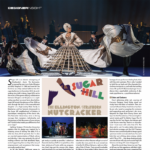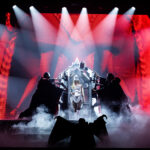
A Conversation with LD Jeff Ravitz
This April, Lighting Designer Jeff Ravitz will celebrate 39 years of lighting Bruce Springsteen. On February 1, Springsteen and the E-Street Band kicked off its 2023 tour, marking the first time in six years that Springsteen and the E Street Band have toured together. One of the most successful bar bands ever, they are still rocking out a high-energy three-hour set each night as they play arenas all across the U.S. before moving to stadium shows this summer. None of the musicians have lost a step, and Bruce is out there from beginning to end to take his fans on a wild musical ride through his deep catalog of music.
“Bruce has never lost that innocence and that drive that made him want to perform in the first place,” says Ravitz. “It’s been great fun working with him and the E Street Band. Over the years I’ve absorbed his aesthetic and really have developed a sense of what he’s trying to convey when he performs.”
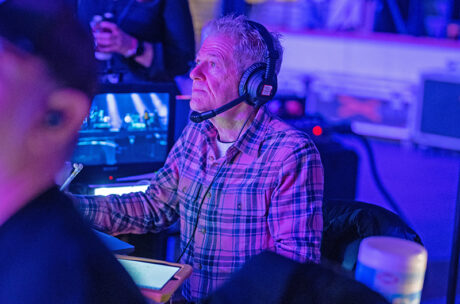
Design Aesthetic
For Ravitz, his design aesthetic starts “more or less with the needs of the show. There are a lot of people on stage, and for this show, it would not be appropriate to light in the style of ‘lead singer is lit, and everybody else is in the background shadows’; everyone’s a major part of the show,” explains Ravitz. “There’s a multi-tiered approach. We keep it simple because, as Bruce reminds me time and again, this is a glorified bar band, and he never wants to lose that vibe and that aesthetic. We try to make sure that there’s a foundation of color through which we reveal each band member in their own individual way. Bruce gets revealed a bit differently than the other musicians that share the mic line with him; the people behind him get revealed differently. It forms sculpted layers from downstage to upstage, not necessarily to suggest hierarchy, but a way to create a visual composition, to see what’s happening — where and when. We begin with those basics and then back into elements like truss configurations and shapes. I’m a big fan of simple setups that serve the needs of the design, and to a certain extent, we don’t significantly change the fundamental positioning and layout of the lighting from tour to tour because the band’s arrangement hasn’t changed much either. I try to make it appear new, but the essence is the same”
Band positions on stage are pretty much where they were in 1984, when Ravitz began lighting them. He notes, “Yes, Bruce has added horns and backup vocals, but the essential core hasn’t really changed. Back to the idea of revealing each musician, I pay close attention to the angles I think are needed to make everybody look their best. Then we ask ourselves—how can we fine-tune those angles to create interesting shadows that give everyone their own distinct look? One of the things that George Travis, our Tour Director, repeatedly says is ‘we know this show has a basic similarity to all previous Bruce Springsteen and The E Street Band tours, but when the audience walks into the arena and sees the stage, they should sense something fresh, new, and different’. Not just a carbon copy of what they saw last time.”

Lights from Above
Ravitz points to an example of where he changed up the rig for an interesting look, creating that ‘something is different’ feeling for the current tour. “The shape and the angling of the trusses is the primary variation,” he says. “I didn’t want to simply shift trusses to different positions, twisting or reshaping them in ways that wouldn’t be practical for the functionality of the lighting, but would only be for the sake of appearance. But just to see where it would take me, I played with assorted truss shapes, arches, angles, and different degrees of bending the truss. Considering we’ve been in the design process for over 18 months, there were many iterations. Finally, I landed on a version that gave the primary trusses over the stage an off-center peak. That felt radically different from The River Tour’s look, where all trussing was flat and straight, as a harkening back to Bruce’s ’80s look. These asymmetric trusses, at their peaks, raise the overall height of the system, so for the first time, we’ve got the grandeur and scale of having majestically high trims, and seeing light emanate from the heavens above.”
Ravitz feels his design approach is done much the same way Springsteen approaches his work—to know what works and keep it. “When we land on something that truly works well, it’s worth hanging onto. We create a variation on a theme to avoid it being a rubber stamp of what we did before, but we have an aesthetic that begins with a color statement, and then systematically reveals all the band members to produce a stage picture. We like to build upon things that have proven successful in the past and expand upon them. One of the things we tried to accomplish on this tour was to extend the lighting past the boundaries of the stage. There’s a mandate to not block sightlines to Bruce’s position on stage, so we’re constantly mindful of where we’re placing lighting positions so that there’s no blockage of sightlines from the highest seats in the arena—and we do seat 360˚. The downstage center position must be visible from everywhere. But, back to the idea of expanding outside the margins, I’ve always enjoyed making the stage “frame” appear wider just by how lights are focused to project past the borders. This time, we actually added several positions far outside the boundaries of the stage to physically widen the entire look.”

A Deep Catalog to Draw From
Ravitz uses his rig thoughtfully throughout the show to create an immense number of looks for the three-hour concert, with an ever fluid set list as Springsteen and the band can draw on an incredibly deep catalog of music. Preparing looks for all the potential songs—and sheer number of songs—is the challenge for lighting, points out Ravitz. “Yes, that is the challenge that I lose sleep over, because the core set list has somewhere between 25 and 35 songs. But as most Springsteen fans know, he can pull from a catalog that is 300+ songs. Realistically speaking, it could be anywhere from 50 to 70 songs on any given night that he might draw from, so we’re constantly looking for ways to do things differently. The look of the current show is an outgrowth of where we began back in the ’80s with the Morpheus PanCommand system, which offered us an ingenious way to organize focuses quickly and neatly; they could be arranged and refocused on a daily basis without a lot of additional time taken. The basic approach of the design is to maintain variety throughout a very long show.”
Ravitz explains the looks needed can range from simpler to the more complicated, much like the music itself. “We’re creating an orchestration from the beginning of the show to the end that takes people through a variety of looks. Some of it involves changing colors and focuses to keep things moving and interesting, but even more, every cue is a true impression of what we think the lighting of each moment in a song should represent. Is it a big, rich, expansive focus? Is it a simple, selectively and dramatically focused look? Once in a while, Bruce will change up the set list and suddenly we’ll get three or four blue songs in a row—which we would generally avoid doing. But every song has such a completely different focus and arrangement and visual layering that even if we do get three blue songs in a row, they’ve all got their own unique character. It’s our mission to do that, as painstaking as it can be. But there are always artistic motivations as well as practical motivations like throwing focus on what’s most important, and to accent the tempos and rhythms, or to jolt and surprise the audience for big musical moments. We are always trying to create variety.”
He continues, “One of my frustrations back in the days of conventional-only fixtures was, for a four-and-a-half-hour show, there would be a monotony of repetition by mid-show, and I’d wish we could lower in a new lighting system with new colors for the second half. Well of course, technology today allows for an unlimited number of colors and an unlimited number of focuses, so every song gets its own unique recipe of wash focuses, gobo focuses, key light combinations, etc. The band themselves all have two or three variations of how I can key light them and backlight them so they can all be sculpted out of the darkness a little differently song by song depending on the material. Like any design, it’s somebody’s impression and somebody’s emotional response to the music. Once in a while, Bruce will give me a specific direction, but we’re mostly left to our own in a dark room, programming overnight. Somebody has to concoct a visual response to the music and the lyrics—color, focus, gobos, timing. It may begin with me, but I’ve got a great team who are urged to contribute, and they do. I don’t know how else it could be done these days with the enormity of productions like this. The team includes me, my programmer and two board operators and an assistant. That gives us a lot of brain power and ten eyes on the stage to try to create good-looking variations on a theme.”
Ravitz’s lighting team for this tour includes Programmer, Mike Appel, “who brings so much experience and talent to what he does,” says the designer. “There’s the tour Lighting Director of over 20 years, Todd Ricci, who is excellent and instinctive at operating console #1 and calling followspots; and Brad Brown, who is our second console operator. Brad operates the board that does much of the heavy lifting in terms of color changes, focuses, and gobos and does an amazing job. Our cueing system is quite complicated, and Todd and Brad have to be in lockstep with the moment-to-moment cueing of the show. The assistant that I brought along on this year’s tour, Violet Smith, was poached from Anne Militello’s graduate program at CalArts. Violet, thankfully, brought a very mature knowledge of lighting to our tech table and was able to help us crunch numbers and track the numerous changes that were happening on a daily basis.”
The Lighting Directors also need to be on their toes for when Springsteen takes an inevitable detour from the set list, but they are prepared for such an eventuality. “We have quite a number of songs that are solidly programmed into the console,” says Ravitz, “but when Bruce pulls an old song from the archives that we haven’t fully programmed, we do have a number of busking looks that are made to work with almost any song. Being able to do that is a necessity of this show. It’s not our favorite thing to do but Todd makes it look easy.”

Key Equipment Choices
During the design process, Ravitz spent many hours looking at spec sheets, going to demos, and playing with samples that were sent to his office to determine what his lighting tools would be for this tour. “One of the more important things to me, on this show, was that we had IP65 rated fixtures because the show will transform in a few months to an outdoor version, so I was looking at weatherproof fixtures. Also, with the exception of eight lights in the show, we are all LED-driven, which was a conscious goal. These days, it’s fairly easy to do because all manufacturers are specializing in excellent LED products.”
The designer went through a number of wash light choices, since “the show is really set up with a battery of wash lights that can do various very visible stage focuses and also create that foundation of color that I was talking about,” Ravitz comments. “We ultimately chose the Martin MAC PXL, which I felt provided us with several advantages. I like the larger aperture of it. Our trim can be fairly high, and this light provides a big, fat beam of light when I need it. But it’s bright, it’s got a beautiful color range, and I felt that as a fixture itself, it had a good look. Most of our profile, hard-edge lights were chosen for their ability to provide the brightness levels that we need, good color, a nice variety of gobos, smooth movement, an even field, and in some cases, be IP65 rated. We’ve gone with a number of Ayrton fixtures on this show. The backbone of the gobo-wash system is the Ayrton Khamsin, and we’re also using that as our primary backlight on performers. As we get further out into the house, we’re using the Ayrton Domino, which is an IP65 fixture with a lot of output, and that is going to serve us quite well on the stadium tour, so I’m pleased with that choice. We’re using the ACME Lyra as our key light. Every band member gets a key light from one or two angles. Bruce’s position has a multitude of angles so we can sculpt him out as we desire in any given cue. The Lyra has excellent color rendition and it’s bright enough to pick out any of the performers through any amount of competing stage light. There’s so much ambient light onstage, and I found the Lyra to be up to the task. It also happens to be IP65.”
As a colorful background for the horn section and vocalists, Ravitz has added a row of Mega-Lite® Circa Scoop XLs behind them. “Those have been a really happy find,” says Ravitz. “They’ve got seven different layers of looks built in. Again, for a Bruce Springsteen show that lasts for hours, we need different tools for different looks. But even more importantly, Bruce and I have been trying to find, for some time now, a really large aperture light. Bruce has always found that there’s a lot of character to lights like a 10K or a 5K, and we’ve played around with them, but they were just impractical and, in a sense, they’re a one-trick pony for how we would use them. The great thing about the Circa Scoop XL is its over-scaled size, with interior LEDs around the reflector, plus a rim of external LED light outlining the fixture. Then there are more LEDs around the center core of the reflector. The result is a light that gives multiple layers of color and effects. We can make it look like a 10K incandescent source, or like a rock ‘n roll light. We finally found that special fixture Bruce has been wanting all these years, and we’re having a lot of fun with it.”
Due to the fact that there are not a lot of vertical surfaces on and around the stage, Ravitz has always been looking to light the stage and the set in a way that created another layer of background. “I’ve always been frustrated that this show doesn’t offer many vertical surfaces to paint with light,” he says. “It’s a more or less flat stage, with a few risers and runways. We’ve added a lot of lighting to make the stage itself pop out. We’ve outlined the stage, band risers, and runways with lighting to graze down the various facias with color and to create extra dimensionality. We’re using a product called Flexglo from Clear Lighting, that’s very bright, and weatherproof as well. The people at TAIT steered us towards that because, as the name implies, it’s flexible and could go around all the curves of the set. This has really given us a brand new look. Upstage, for the runway façades, we’re using the Chroma-Q Color Span 2. It’s a low profile fixture with a very high output. And the icing on the cake is the Martin VDO Dotron. It’s a long string of puck lights on steroids that outlines the front face of the stage and defines the edges of the runways, colorfully and with lots of excitement-value . Much of this set lighting was conceived with the stadium show in-mind, because we start the show before dark, and we need elements that are not only going to read in the daylight but will also provide a big punch when we do songs with full house lights on.”
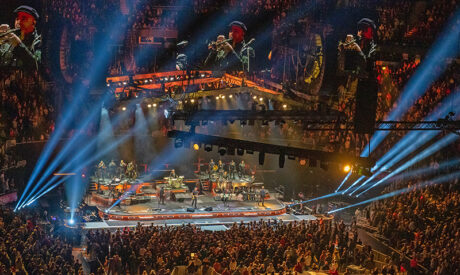
Bring the Lights Up
The audience is a big part of a Bruce Springsteen and the E Street Band show, and the lighting has always addressed the audience. In fact, beyond audience lighting, there are also portions of the show with the house lighting turned on. “The audience has always been an essential part of the show, and we play with bringing them into the show environment, extending the performance area all the way to the back row,” Ravitz notes. “We looked for a good light that would adequately and smoothly light the audience, but not blind them in a way that would be glary and uncomfortable. We’re using the Elation CUEPIX 16-IP, which allows us a full range of color. It’s a nice-looking fixture with a smooth field of coverage. Then we’re combining the CUEPIX with the CHAUVET Color STRIKE M, which is a tilting, pixelated wash light with a kick-ass strobe element. Between those two fixtures, we can get quite a lot of light on the audience, and also add dynamic accents to keep up with the rhythm and tempo of the show. This one-two combination is really effective. As for the house lights coming on during the encores, that’s a tradition that I inherited that goes back to Bruce’s earliest days. When I came to the job in 1984, I was told the house lights come on when Bruce plays ‘Born to Run’. It’s carefully coordinated between the tour staff and the house light operator. These days with LED house lights, they’re able to snap on in one instant blast. But suddenly the stage is flooded with house lights spilling over, washing out all stage light—even though we do keep the lights on—but it’s Bruce’s way of equalizing the show and the crowd; letting the audience join him. The whole arena is now the stage.”
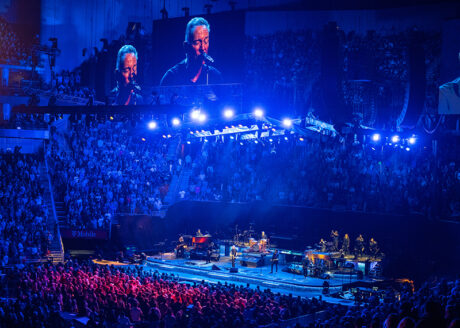
A True Team
When asked about how involved Springsteen is when it comes to the lighting and design ideas, Ravitz is quick to point out “It’s not just Bruce. The entire band takes ownership. I get a lot of good comments and have many productive conversations with other band members who point out moments in the show that are sometimes so subtle that we don’t catch them on first listen. It’s really vital to the design, and every member of the band has been so important in helping get this show to where it is. And of course, there’s my team; I have to say the touring team is really who deserves much of the credit because they’re out there on a day-to-day basis making this happen and delivering an incredible show.”
As for his feelings about the success of this latest design for Bruce Springsteen and the E Street Band, Ravitz says, “The gist of the show is make it clean… make it powerful… make it flexible. We are ready to go left or right at any given moment with this design, because we need to make our part of the show as powerful as Bruce’s and the band’s performance. I think we are succeeding, so it seems we have accomplished our mission. And for me, the best part is working with remarkable artists like Bruce and his band.”


